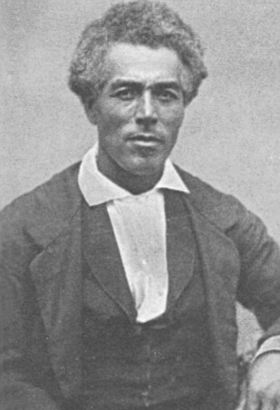Black History
Horace King: A Genius Builder and Architect in Old South
One of the greatest fears of a slave owner was Black literacy. An uneducated slave was thought to be nonthreatening and “necessary to their security.”

One of the greatest fears of a slave owner was Black literacy. An uneducated slave was thought to be nonthreatening and “necessary to their security.”
Reading and writing posed a threat to the system of slavery, and strict laws were enforced against it. Simply put: educating an enslaved person was a crime. John Godwin, however, ignored this law, giving his slaves, including Horace King (1807–1885), a great degree of freedom.
King was born in South Carolina. He was taught to read early and thought to have been literate when purchased by Godwin around 1830. Soon after, Godwin, a builder, relocated from Alabama to a suburb of Columbus, Ga. There, he was awarded the contract to build the first public bridge connecting the two states.
It is said that King planned the project and supervised the enslaved people tasked to erect the span. It was then that Godwin realized King’s talents and natural genius as a builder. He made the decision to take King on as his protégé. Soon after, he sent King to Oberlin College (Ohio), the first college to admit African-American students.
After graduation, King returned to work with Godwin. The two collaborated on the construction of courthouses and bridges throughout Georgia and Alabama. In 1841, they rebuilt their Columbus City Bridge which had been destroyed in a flood.
King also served as superintendent and architect of major bridges at Wetumpka, Ala., and Columbus, Miss. Godwin did not supervise those projects.
Godwin experienced financial difficulties in the late 1830s, forcing him to transfer ownership of King to his wife and her uncle. In 1846, King was freed. It is said that Godwin came to these decisions because he needed to “protect this valuable asset (King) from his creditors.”
King could possibly have bought his freedom, but the relationship between the two men continued.
In the mid-1850s, King erected Moore’s Bridge, which stretched over the Chattahoochee River between Newnan and Carrollton. In lieu of cash, he accepted stock in the enterprise as payment. King’s wife and their five children are believed to have moved to this site. There they tended the bridge and farmed until 1864, when the Union cavalry burned the span.
The Civil War (1861–65) brought an economic boom to Columbus. King, at that time, worked for the Confederacy, supplying timber. He also took on the project of erecting a major building for the Confederate navy.
During Reconstruction (1863–77), King became a Republican politician. He served two terms as a member of the Alabama House of Representatives, although his presence was minimal. His focus was on rebuilding wagon and railroad bridges, grist and textile mills, cotton warehouses, and public buildings. He did not seek a third term.
In 1872, King and his family moved to LaGrange, Ga., where he continued to design and construct bridges, stores, houses, and college buildings. He had become the most respected bridge builder in west Georgia, Alabama, and northeast Mississippi from the 1830s until the 1880s. King died in 1885.
Activism
Oakland Post: Week of April 24 – 30, 2024
The printed Weekly Edition of the Oakland Post: Week of April 24 – 30, 2024

To enlarge your view of this issue, use the slider, magnifying glass icon or full page icon in the lower right corner of the browser window. ![]()
Activism
Oakland Post: Week of April 17 – 23, 2024
The printed Weekly Edition of the Oakland Post: Week of April 17 – 23, 2024

To enlarge your view of this issue, use the slider, magnifying glass icon or full page icon in the lower right corner of the browser window. ![]()
Black History
Matthew Henson: Explorer Extraordinaire
Matthew Henson, a trailblazing explorer who overcame countless obstacles to leave an incredible mark on history. Born on August 8, 1866, in Charles County, Maryland, his journey is a testament to the power of determination and the spirit of adventure.

By Tamara Shiloh
Matthew Henson, a trailblazing explorer who overcame countless obstacles to leave an incredible mark on history. Born on August 8, 1866, in Charles County, Maryland, his journey is a testament to the power of determination and the spirit of adventure.
Henson’s life began amidst the backdrop of post-Civil War America, where opportunities for African Americans were scarce. From a young age, he possessed an insatiable curiosity about the world beyond his small town. At the age of 12, he embarked on a journey that would change the course of his life forever when he joined a merchant ship as a cabin boy.
His most famous expedition was his journey to the Arctic with renowned explorer Robert E. Peary. In 1887, Henson joined Peary’s crew as a seaman and quickly proved himself to be invaluable with his skills as a navigator and craftsman. Over the course of several expeditions, Matthew endured extreme cold, treacherous terrain, and grueling conditions as he and Peary sought to reach the elusive North Pole.
In 1908–09, Peary set out on his eighth attempt to reach the North Pole. It was a big expedition, with Peary planning to leave supplies along the way. When he and Henson boarded their ship, the Roosevelt, leaving Greenland on August 18, 1909, they were joined by a large group. This included 22 Inuit men, 17 Inuit women, 10 children, 246 dogs, 70 tons of whale meat, blubber from 50 walruses, hunting gear, and tons of coal.
In February, Henson and Peary left their anchored ship at Ellesmere Island’s Cape Sheridan, along with the Inuit men and 130 dogs. They worked together to set up a trail and supplies along the way to the Pole.
Peary picked Henson and four Inuit people to join him in the final push to the Pole. However, before they reached their destination, Peary couldn’t walk anymore and had to ride in a dog sled. He sent Henson ahead to scout the way. In a later interview with a newspaper, Henson recalled being in the lead and realizing they had gone too far. The group turned back, and Henson noticed his footprints helped guide them to their destination. At that location, Henson planted the American flag.
Henson’s legacy extends far beyond his expeditions to the Arctic. He shattered racial barriers in the world of exploration and inspired countless individuals, regardless of race, to dream big and pursue their passions. In 1937, he was finally recognized for his achievements when he was inducted into The Explorers Club, an organization dedicated to promoting scientific exploration and field research.
Matthew Henson died in the Bronx, New York, on March 9, 1955, at the age of 88.
-

 Activism4 weeks ago
Activism4 weeks agoOakland Post: Week of March 27 – April 2, 2024
-

 #NNPA BlackPress4 weeks ago
#NNPA BlackPress4 weeks agoBeloved Actor and Activist Louis Cameron Gossett Jr. Dies at 87
-

 Community1 week ago
Community1 week agoFinancial Assistance Bill for Descendants of Enslaved Persons to Help Them Purchase, Own, or Maintain a Home
-

 Activism3 weeks ago
Activism3 weeks agoOakland Post: Week of April 3 – 6, 2024
-

 Business1 week ago
Business1 week agoV.P. Kamala Harris: Americans With Criminal Records Will Soon Be Eligible for SBA Loans
-

 Activism2 weeks ago
Activism2 weeks agoOakland Post: Week of April 10 – 16, 2024
-

 Community1 week ago
Community1 week agoAG Bonta Says Oakland School Leaders Should Comply with State Laws to Avoid ‘Disparate Harm’ When Closing or Merging Schools
-

 Community6 days ago
Community6 days agoOakland WNBA Player to be Inducted Into Hall of Fame























































